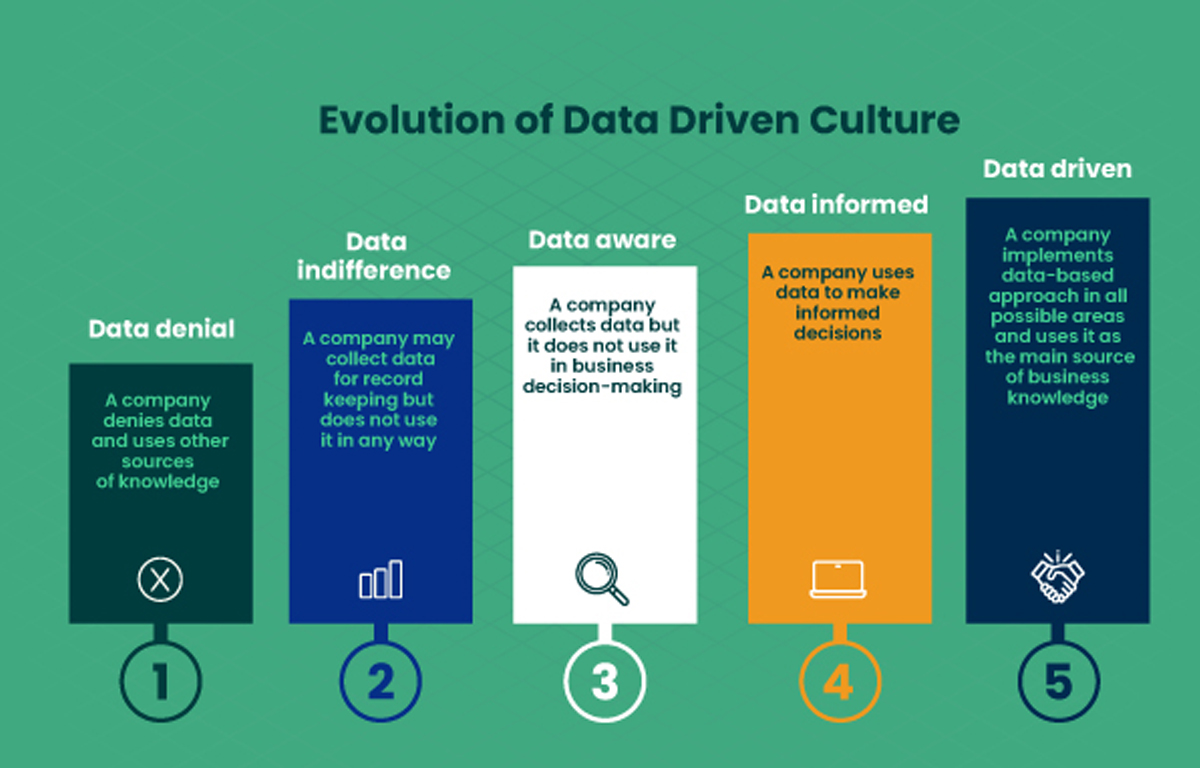What Is Data Driven Decision Making
In today’s data-driven world, businesses of all sizes are increasingly relying on data to make informed decisions. Data-driven decision making (DDDM) is the process of using data to guide strategic business decisions that align with your goals and strategies. It is a process that involves collecting, analyzing, and interpreting data to gain insights that can be used to improve business performance.

Why is DDDM important?
DDDM is important for businesses because it allows them to:
Make better decisions that are based on evidence, not intuition.
Identify and solve problems more quickly and effectively.
Improve customer satisfaction and loyalty.
Increase productivity and efficiency.
Gain a competitive advantage.
How does DDDM work?
The DDDM process typically involves the following steps:
Identify the business problem or opportunity.
Collect data that is relevant to the problem or opportunity.
Analyze the data to identify patterns and trends.
Interpret the findings and draw conclusions.
Communicate the findings to stakeholders.
Take action based on the findings.
What are the benefits of DDDM?
There are many benefits to DDDM, including:
Improved decision-making: DDDM can help businesses make better decisions that are based on evidence, not intuition.
Increased efficiency: DDDM can help businesses identify and eliminate waste and inefficiency.
Reduced costs: DDDM can help businesses reduce costs by making better decisions about resource allocation.
Improved customer satisfaction: DDDM can help businesses improve customer satisfaction by identifying and addressing customer needs and preferences.
Enhanced innovation: DDDM can help businesses enhance innovation by identifying new opportunities and developing new products and services.

How can businesses implement DDDM?
To implement DDDM, businesses need to:
Develop a data-driven culture: This means creating a culture where data is valued and used to make decisions.
Invest in data infrastructure: This includes hardware, software, and people to collect, store, and analyze data.
Develop data literacy: This means training employees to understand and use data.
Implement data governance: This means establishing policies and procedures for managing data.
Use data visualization tools: This can help businesses make sense of complex data sets.
Hire data scientists: This can help businesses analyze data and extract insights.
DDDM in the Real World
Many businesses are already using DDDM to great success. For example, Amazon uses DDDM to recommend products to customers, Netflix uses DDDM to personalize the viewing experience for its users, and Walmart uses DDDM to optimize its supply chain.
The Future of DDDM
DDDM is only going to become more important in the future as the amount of data continues to grow. Businesses that are able to effectively collect, analyze, and use data will have a competitive advantage.

Data-Driven Decision Making in LMS: Propelling E-Learning Excellence
In the dynamic realm of education and training, data-driven decision-making (DDDM) has emerged as a transformative force, empowering organizations to optimize learning outcomes, enhance employee performance, and achieve their strategic goals. By leveraging the rich tapestry of data generated by Learning Management Systems (LMS), organizations can gain invaluable insights into student engagement, course effectiveness, and overall program performance. This data-centric approach enables informed decision-making, leading to personalized learning experiences, improved resource allocation, and ultimately, measurable improvements in organizational outcomes.
The Power of LMS Data: A Treasure Trove of Insights
LMS platforms collect a wealth of data, encompassing student engagement metrics, assessment results, course completion rates, and feedback surveys. This data trove holds the potential to revolutionize educational and training practices, if harnessed effectively. DDDM involves the systematic collection, analysis, and interpretation of LMS data to inform strategic decision-making. It empowers educators and trainers to move beyond anecdotal evidence and embrace a data-backed approach to enhancing learning and training effectiveness.
Unlocking Insights for Enhanced Learning and Training Outcomes
DDDM can revolutionize various aspects of education and training, from course design and delivery to student support and program evaluation. Here are some key areas where DDDM can make a significant impact:
Personalized Learning Pathways
By analyzing student data, educators and trainers can identify individual strengths, weaknesses, and learning styles. This data-driven approach enables the creation of personalized learning pathways that cater to specific needs and preferences, fostering improved comprehension, engagement, and retention rates.
Adaptive Courseware
DDDM facilitates the development of adaptive courseware that dynamically adjusts to each student’s progress and learning style. This personalized approach ensures that students are challenged at an appropriate level, maximizing their learning potential and minimizing frustration.
Predictive Analytics
Predictive analytics models, powered by LMS data, can identify students or employees at risk of falling behind or facing challenges. This proactive approach allows for timely interventions and targeted support services, preventing individuals from falling behind and ensuring they stay on track to achieve their learning or training goals.
Data-Driven Instructional Design
DDDM guides the creation of effective instructional materials and activities, aligning course content with student preferences, learning modalities, and skill gaps. This data-informed approach ensures that courses are engaging, relevant, and tailored to the specific needs of the target audience.
Informed Resource Allocation
DDDM optimizes resource allocation by identifying the most effective training programs and initiatives. By analyzing course completion rates, assessment performance, and impact on employee performance, organizations can direct resources towards programs with proven impact, maximizing the return on investment in training and education.
Empowering Educators and Trainers with Data Literacy
To fully realize the benefits of DDDM, it is crucial to equip educators and trainers with the necessary data literacy skills. This includes understanding data analysis principles, interpreting data visualizations, and effectively communicating data-driven insights to stakeholders. Professional development programs can empower educators and trainers to become active participants in the DDDM process, transforming them from data collectors to data analysts and informed decision-makers.
Overcoming Challenges and Embracing the Future
While DDDM holds immense potential, it is not without its challenges. Organizations must address data privacy concerns, implement robust data security measures, and establish data governance frameworks to protect sensitive information. Additionally, fostering a culture of data-driven decision-making requires buy-in from all levels of the organization, from educators and trainers to administrators and policymakers.

Five Steps to Data-Driven E-Learning Success
1. Establish Clear Objectives: Define specific and measurable goals for your e-learning or training programs, ensuring that data collection and analysis align with these objectives.
2. Identify Key Performance Indicators (KPIs): Determine the metrics that best reflect the success of your e-learning or training programs, such as course completion rates, assessment performance, employee productivity gains, and skill acquisition levels.
3. Leverage LMS Data Analytics Tools: Utilize built-in LMS analytics tools or invest in specialized data analytics platforms to effectively gather, analyze, and visualize LMS data.
4. Transform Data into Actionable Insights: Interpret data patterns and trends, identifying areas for improvement and opportunities to enhance e-learning or training effectiveness.
5. Communicate Insights to Stakeholders: Share data-driven insights with educators, trainers, administrators, and decision-makers, ensuring that data informs strategic decision-making across the organization.
Conclusion: Embracing Data-Driven E-Learning Excellence
By embracing DDDM and harnessing the power of LMS data, organizations can transform their e-learning and training programs into powerful catalysts for employee growth, enhanced productivity, and ultimately, organizational success. Data-driven insights empower educators and trainers to personalize learning experiences, optimize resource allocation, and make informed decisions that drive measurable improvements in employee performance and organizational outcomes. As organizations navigate an ever-evolving landscape of learning


